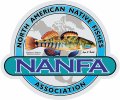Captive Care Notes: Bay Anchovy (Family Engraulidae)
Bay anchovies are fragile fishes that often lose their scales when caught in a net or handled. Since their scales are part of a rather thin layer of skin, death quickly follows. But aquarists at the Dauphin Island Sea Lab Estuarium in Dauphin Island, Alabama, have had success in maintaining the species in captivity. The key, according to Dauphin Island aquarist Brian Jones (pers. comm.), is gentle capture, rapid transfer from the collection site, and frequent feedings. It also helps that prime bay anchovy habitat is just outside the Estuarium's back door.
"In late April, the anchovies school in great numbers in the Mobile Bay estuary," Brian said. "We noticed that these schools sometimes come into the shallow water near our research boat dock. Once we spotted a large school in the right spot, we loaded up a clean 55-gallon trash can and headed down to the dock with a seine. We were able to catch a couple hundred anchovies and transport them to the display tank within 15 minutes. We had prepared the 300-gallon circular tank ahead of time to match collection site conditions for salinity (25 ppt), temperature (74F), and pH (8.0). We treated them for about a week with antibiotics to manage capture injuries. A good bit of mortality happened over the first week or two, but probably 70% survived after that. Most of them survived a full year, and we were surprised to have a couple dozen last a full two years." The anchovies are fed twice a day with a variety of small foods, including frozen brine shrimp, small krill, and Cyclop-eeze. An automatic feeder supplied flakes four times a day. Mechanical filters are replaced and 25% water changes are performed every week.Researchers studying the growth and food requirements of larval bay anchovy collected in Florida have successfully hatched their eggs in laboratory aquaria. In order to maintain at least a 50 percent survival rate, the newly hatched anchovies needed their water to be "conditioned" by an ever-present bloom of marine phytoplankton at a concentration of 2,000 copepod nauplii per liter.
